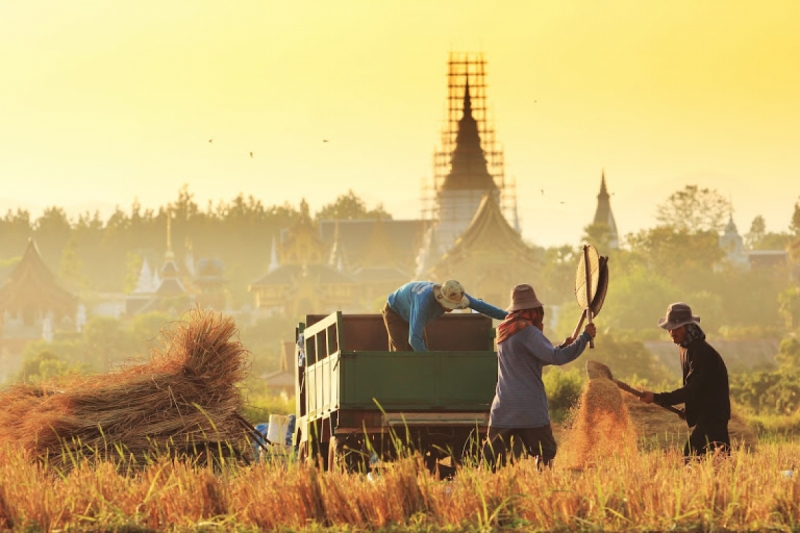




The Asian economy is one that has survived the hit of the financial crisis that struck Europe and the United States in the past decade. In the Economic Outlook report for 2014 for Southeast Asia, China and India, it is projected that the economy will remain robust for the next four years until 2018. Growth of the emerging Asian Economies is projected at 7% annually, thanks to the continued rise in domestic demands, infrastructural improvements and economic reforms and policies.
The report also noted the countries’ respective policy challenges and focus in the medium-term, such as land scarcity and the ageing population for Singapore, and resilience and adaptation to natural disasters for the Philippines. For the countries in the Lower Mekong, the emphasis remains on improving agricultural productivity.
But while the economic outlook is promising, the wins in the increase in the GDP and national income should be adequately reflected in other social indicators. The issue of food security for one should be a key issue for countries where agricultural production remains the number one source of livelihood of the people and contributes the biggest chunk to the overall economy. According to data from CGIAR Big Facts for East and Southeast Asia, food inequality between the rich and poor as a result of the changing diet, food consumption and eating patterns are likely to increase. Flooding as a result of the unpredictable weather patterns and rising seawater levels can have detrimental impacts on agricultural lands and lead to an overall loss in production. Salinization is a future threat for those in the Mekong Delta.
The Grow Asia Initiative
Along with these challenges is the fact that the booming population of the world only means more mouths to feed and therefore, more food to produce. With the changing environmental landscape, there is also a pressing need to pursue sustainable agriculture that makes use of limited environmental resources.
Recognizing these challenges, the World Economic Forum along with the ASEAN Secretariat, launched in May this year the Grow Asia initiative. The initiative is anchored on collaboration and partnerships among private and public stakeholders in the region with the ultimate goal of promoting sustainable and inclusive agriculture.
Grow Asia is meant to serve as a “partnership platform” that will explore scalable solutions to address issues in the overall agricultural production chain. With a bias to household-level farmers, the partnership hopes to enable smallholder producers see a 20% increase in their yield and profits and at the same time, reduce the water use and greenhouse gas emission per tonne of production by 20%.
Grow Asia members are comprised of the ASEAN country governments, donors, international organisations, farmer groups, the Grow Asia Business Council (chaired by Nestle and Sinar Mas), and the Grow Asia Civil Society Council (non-profit organisations like Rainforest Alliance and The Nature Conservancy).
Building on existing partnerships
Grow Asia is not a new initiative however; rather, it is intended to complement and support current and existing collaborations. Furthermore, the initiative’s activities are meant to build on and contribute to the agriculture agenda and priorities of the member countries. Ultimately, the inter-country partnerships can raise the level of agricultural production and foster healthy regional trade that is most advantageous for smallholder farmers.
The launching of Grow Asia at the World Economic Forum in May 2014 was the first in a series of activities that the partnership has lined up. The forum brought together various stakeholders and served as the venue to articulate and reiterate the commitment to the partnership and to fight against food insecurity in the region. A second gathering this 2015 in Indonesia is in the works with the hope to explore investment opportunities and partnerships for agricultural producers.
Currently, Grow Asia’s activities are concentrated on four existing partnerships in the region, namely, the Vietnam Public Private Task Force on Sustainable Agriculture, Partnership for Indonesia’s Sustainable Agriculture (PISAgro), Myanmar Agriculture Network, and the Philippines Partnership for Sustainable Agriculture.
The Grow Asia partnership is a welcome initiative especially in light of the 2015 ASEAN Integration. But more than raising the bar of agriculture, even more important is ensuring that the region – and the rest of the world – are ready to feed the projected 9 billion people by 2050. For countries in Southeast Asia, this may seem a tall order indeed. Grow Asia is only one of the many other ways to ensure that we make it happen.